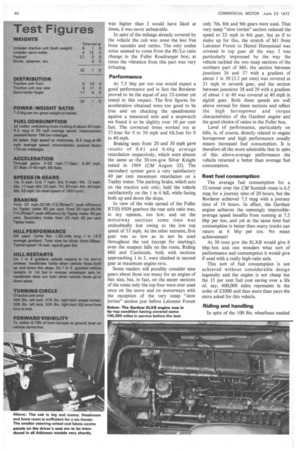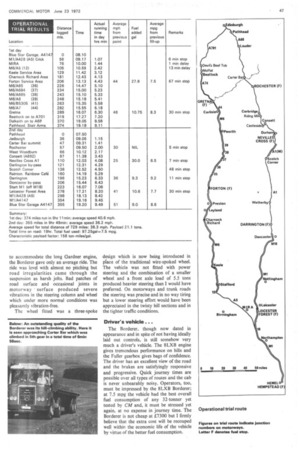Atkinson Borderer/Municipal 32-ton-gew artie
Page 44

Page 46

Page 47

If you've noticed an error in this article please click here to report it so we can fix it.
by Gibb Grace, DAuE, CEng, MIMechE
MANY OPERATORS who run 180 bhp vehicles at 32 tons gcw bemoan the fact that from April 1 1973 vehicles built after October 1 1972 with this horsepower will be limited to 30 tons gcw. Although bigger engines are available to run at 32 tons operators argue that the cost of operating
them will inevitably increase. However, CM has just tested an Atkinson Borderer fitted with a 240 bhp Gardner 8LXB engine at 32 tons gm and can report that in this instance, at least, the Gardner gives improved performance at much better than average fuel consumption. So great has been
the demand for 8LXB-engined vehicles that the Atkinson factory has not had a chance to build a demonstrator, and for this test we used a vehicle from John Raymond's fleet which had already covered some 100,000 miles in service.
The vehicle was looked over by Atkinson and Gardner before the test, but only the normal routine maintenance was deemed necessary to put it in tip-top condition.
Cab and driver comfort The MkII cab of the Atkinson is dated in appearance and still very stark by current European standards. Entry to the cab is easy, if a little unusual, via a step on the rear of the cab. The immediate impression from the driver's seat is one of space. The cab is extremely roomy and visibility through the large split-screen remarkably unrestricted. A suspension seat for the driver has been standard for some time but current vehicles have "breathing fabric" centre panels to seat cushions and squabs With the seat adjusted to the highest position — I am 6ft lin. tall — there is still ample head clearance and knee room below the wheel.
With so much room available it is a pity that the wheel and pedals are not better placed in relation to each other. The wheel is displaced slightly to the left of centre giving brake and accelerator plenty of room, but the clutch is displaced much too far to the left and so is awkward to operate.
The clutch pedal load though is pleasantly light, and in time I became used to its positioning. The brake pedal is well placed and very smooth in action, but the accelerator is a throwback to yesteryear, being a high-set treadle needing much too high an effort to operate it. Unfortunately, owing to linkage stickiness, proper control of the throttle was even more difficult, making driving at anything other than full throttle very wearing indeed.
Two mirrors are now fitted as standard and these are mounted on substantial outriggers and give a vibration-free rear view, uninterrupted by cab pillars, etc. In rain, rearview vision did tend to become obscured by water and grime which had blown around the wrap of the screen but the mirror glass itself remained clear.
A new perforated cab trim which is backed up with a sound absorbent foam plastic helped keep noise in the cab to a reasonable level. At the maximum rated engine speed (equivalent to 53 mph in top gear) the noise level made conversion across the cab difficult, but at lower or higher speeds than this the noise level improved noticeably. The characteristic note of the 8LXB is akin to a muffled rumble and quite pleasant compared to the more raucous characteristic note of, say, a V-8. For this reason, although the noise level was higher than I would have liked at times, it was never unbearable.
In spite of the mileage already covered by the vehicle the cab was none the less free from squeaks and rattles. The only undue noise seemed to come from the Hi /Lo ratio change in the Fuller Roadranger box; at times the vibration from this part was very irritating.
Performance At 7.5 bhp per ton one would expect a good performance and in fact the Borderer proved to be the equal of any 32-tonner yet tested in this respect. The first figures for acceleration obtained were too good to be true and on checking the speedometer against a measured mile and a stopwatch we found it to be slightly over 10 per cent fast. The corrected times worked out at 37.6sec for 0 to 30 mph and 68.5 sec for 0 to 40 mph.
Braking tests from 20 and 30 mph gave results of 0.41 and 0.44g average retardation respectively, which were almost the same as the 30-ton-gcw Silver Knight tested in 1969 (CM August 22). The secondary system gave a very satisfactory 40 per cent maximum retardation on a Tapley meter. The parking brake, which acts on the tractive unit only, held the vehicle satisfactorily on the 1 in 6 hill, while facing both up and down the slope.
In view of the wide spread of the Fuller RT(0) 9509 gearbox the rear axle ratio was, in my opinion, too low, and on the motorway sections some time was undoubtedly lost owing to the low top speed of 53 mph. At the other extreme, first gear was so low as to not be used throughout the test (except for starting); even the steepest. hills on the route, Riding Mill and Castleside, both with sections approaching 1 in 5, were climbed in second gear at maximum engine revs.
Some readers will possibly consider nine gears about three too many for an engine of this size, but, in fact, on the easier sections of the route only the top four were ever used once on the move and on motorways with the exception of the very steep "slow lorries" section just before Leicester Forest Below: The Gardner Blial engine was in
only 7th, 8th and 9th gears were used. That very steep "slow lorries" section reduced the speed to 22 mph in 6th gear, but as if to make up for this, the stretch of M1 from Leicester Forest to Hemel Hempstead was covered in top gear all the way. I was particularly impressed by the way the vehicle tackled the two steep sections of the northern part of M6; the section between junctions 36 and 37 with a gradient of about I in 30 (3.3 per cent) was covered at 31 mph in seventh gear, and the section between junctions 38 and 39 with a gradient of about 1 in 40 was covered at 40 mph in eighth gear. Both these speeds are well above normal for these sections and reflect the high horsepower and torque characteristics of the Gardner engine and the good choice of ratios in the Fuller box.
Level of performance, particularly on hills, is, of course, directly related to engine. horsepower and high performance usually means increased fuel consumption. It is therefore all the more admirable that in spite, of this above-average performance the vehicle returned a better than average fuel consumption.
Best fuel consumption The average fuel consumption for a 32-tonner over the CM Scottish route is 6.5 mpg for a journey time of 20 hours, but the Borderer achieved 7.5 mpg with a journey time of 19 hours. In effect, the Gardner engine achieves the seemingly impossible; average speed benefits from running at 7.5 bhp per ton, and yet at the same time fuel consumption is better than many trucks can return at 6 bhp per ton. No mean achievement!
At 30 tons gew the 8LXB would give 8 bhp/ton and one wonders what sort of performance and consumption it would give if used with a really high-ratio axle.
This sort of fuel consumption is not achieved without considerable design ingenuity and the engine is not cheap but the IS per cent fuel cost saving over a life of, say, 400,000 miles represents in the order of 0000 and thus more than pays the extra asked for this vehicle.
Riding and handling In spite of the 10ft ain. wheelbase needed to accommodate the long Gardner engine, the Borderer gave only an average ride. The ride was level with almost no pitching but road irregularities came through the suspension as harsh jolts. Bad patches of road surface and occasional joints in motorway • surface produced severe vibrations in the steering column and wheel which under more normal conditions was pleasantly vibration-free.
The wheel fitted was a three-spoke design which is now being introduced in Place of the traditional wire-spoked wheel. The vehicle was not fitted with power steering and the combination of a smaller wheel and a front axle load of 5.5 tons produced heavier steering than I would have preferred. On motorways and trunk roads the steering was precise and in no way tiring but a lower steering effort would have been appreciated in the twisty hill sections and in the tighter traffic conditions.
Driver's vehicle.
The Borderer, though now dated in appearance and in spite of not having ideally laid out controls, is still somehow very much a driver's vehicle. The 81.AB engine gives tremendous performance on hills and the Fuller gearbox gives bags of confidence. The driver has an excellent view of the road and the brakes are satisfyingly responsive and progressive. Quick journey times are possible over all types of routes and the cab is never unbearably noisy. Operators, too, must be impressed by the 81AB Borderer; at 7.5 mpg the vehicle had the best overall fuel consumption of any 32-tonner yet tested by CM and, it must be stressed yet again, at no expense in journey time. The Borderer is not cheap at £7300 but I firmly believe that the extra cost will be recouped well within the economic life of the vehicle by virtue of the better fuel consumption.












































































































